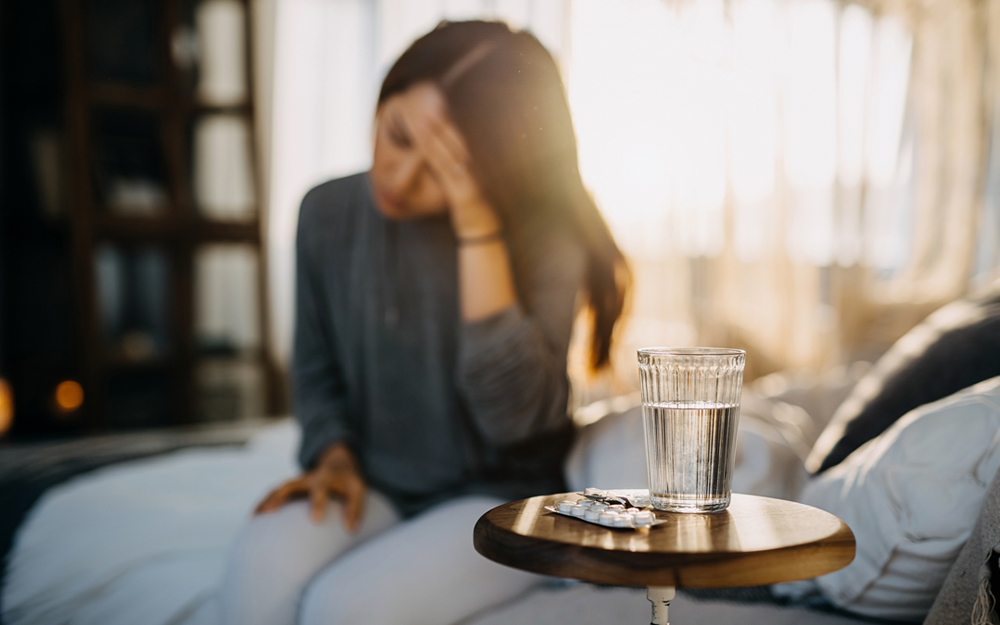Cedars-Sinai Blog
Managing Migraines Amid COVID-19
Mar 16, 2021 Victoria Pelham

Migraines can be incredibly painful and disruptive, forcing sufferers to hide away from light and under bed covers for hours or even days.
Staying at home during the COVID-19 pandemic hasn't done anything to help this prevalent condition. For many people, it's had the opposite effect: Doctors are seeing a tidal wave of patients either newly experiencing migraines or having their headaches escalate—and those hours of suffering creep up.
Read: Know Your Headaches

Nancy Sicotte, MD
"That's a lot of lost time that could be potentially avoided," says Dr. Nancy Sicotte, chair of the Cedars-Sinai Department of Neurology.
One survey of more than 1,000 migraine sufferers found nearly 60% of respondents had their migraines get more frequent during COVID-19. For the majority—64.1%—they grew more severe.
Rates are swelling alongside pandemic-related upheaval. Stress, anxiety, increased screen time and disturbances to sleep and schedules are all significant migraine risk factors, Dr. Sicotte says.
While we can't always control stressful circumstances, Dr. Sicotte says there's much we can do to boost our brain's ability to cope.
Maintain consistency
The pandemic has interrupted most everyone's schedules, with many schools and jobs virtual and indoor spaces such as gyms closed or limited. But sticking to a regular schedule is crucial for mitigating migraine symptoms.
"The migraine brain requires consistency," Dr. Sicotte says.
Introduce a new routine that makes sense for you during COVID-19. That includes going to bed and getting up at the same time each day, regardless of your work schedule or the day of the week.
Diet is also key—skipping meals can throw you off balance. Make sure you're eating meals and drinking water regularly, and if you do drink caffeine, keep the amount steady. So, if you have a cup of coffee one day, try to keep it to just one cup every day.
Pay attention to food triggers
Practice moderation, because certain foods or drinks (such as caffeine and alcohol) in excess can be problematic.
Other triggers might affect you even in small doses. Getting to know your personal triggers can be a great starting point to learning to better manage migraines.
Common culprits include aged cheese, caffeinated dark chocolate and drinks with tannins or congeners such as red wines and dark whiskeys. Food sensitivities—to gluten, for example—can prompt migraines as well.
One tool Dr. Sicotte recommends is a food journal. Documenting your food and drink intake can help you pinpoint what's causing your migraines or making them worse.
Start your journal before meeting with a neurologist, so you come in armed with information, she suggests.
Once potential triggers have been identified, the idea is to limit or modify them and track your results.
"The migraine brain requires consistency."
Manage stress
Stress and anxiety can be powerful migraine triggers, Dr. Sicotte points out. Both are spiking with the uncertainty around COVID-19.
To combat them, break up your screen time by getting outside in nature and staying physically active, Dr. Sicotte says. You could go for a walk or try yoga and gentle stretching—whatever keeps you moving.
Meditation can also help you to unwind.
Amid physical distancing guidelines, relationships are trickier to maintain, but they're still vital to getting through challenging times, she adds. Continue to lean on your support system.
Try natural supplements
For people experiencing frequent migraines (more than two times a week) or chronic headaches, Dr. Sicotte recommends supplements such as magnesium and riboflavin. Formulations containing both in one are available over the counter.
These supplements taken at night have been shown to reduce both frequency and severity of some headaches. One 2015 study of 130 adult migraine sufferers found that treatment with one of these supplements decreased migraine frequency from 6.2 days per month to 4.4 days and significantly reduced the intensity of migraine pain.
"That's a lot of lost time that could potentially be avoided."
Know when to seek professional care
"Any new onset headache in someone who's over 50 years old requires immediate attention," Dr. Sicotte cautions.
Head to an emergency room for evaluation if you experience:
- Any sudden, severe headache.
- Focal neurological signs (such as weakness, numbness, change in vision or difficulty speaking) that don't resolve within 30-60 minutes or occur alongside a headache—Migraines often come with an "aura" phase consisting of visual, sensory, speech and motor changes, but these symptoms should be short-lived and finished by the time your headache starts.
- Changes in headache quality or intensity.
- "The worst headache of your life," which could indicate a serious medical problem such as brain hemorrhage.
- More than four headaches per month
- One or more headaches per week
- Severe headaches that are debilitating and long-lasting
Find the right treatment option
The science around migraines has dramatically advanced in recent years, with the introduction of highly effective therapies involving monoclonal antibodies and discoveries into the role genetics and women's hormonal fluctuations play in triggering them.
Migraines are better understood—and more treatable—than ever, Dr. Sicotte says.
A neurologist will often start with a headache diary to determine the relationship between your behavior and your migraines. Then they can prescribe the best medications for your condition.
Treatments include abortive medications—such as triptan drugs—that you can take when you feel a headache coming on and prophylactics you can take regularly to prevent new headaches.
Providers also often offer Botox for prevention and trigger-point injections for muscle relief. There are so many options for treatment that, Dr. Sicotte says, "people should not suffer unnecessarily."


